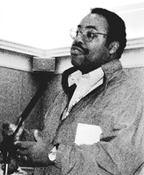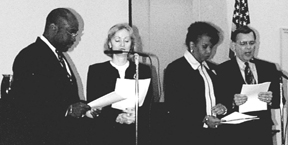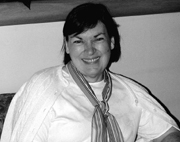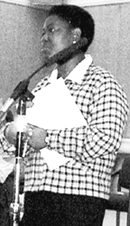
| T H E N I H C A T A L Y S T | J A N U A R Y - F E B R U A R Y 1999 |
|
|
|
DIVERSITY ISSUES LEAP OFF THE PAGEONTO THE CAMPUS |
by Fran Pollner |
 |
|
Ron
King
|
Ron King, chief of the NHGRI tech-transfer office, stood at the mike and scanned the faces of those occupying the seats around him in Wilson Hall, where a public forum on "diversity in the workplace" had just opened up for audience questions and comments.
"I don’t see too many rank-and-file scientists here," he said, registering his disappointment before commenting on the issues raised.
During the preceding hour, there had been a reading from a novel that dramatized race, sex, and class dynamics in a Los Angeles bank, followed by a panel discussion applying the book’s issues to the scientific world at NIH. The forum, held November 30, was the second of a scheduled five in the Diversity Book Bridge Project offered by the NIH Office of Equal Opportunity. According to Gary Morin, an OEO program analyst for diversity, this particular forum was "aimed at scientists in the workplace, while the series overall is aimed at all NIH employees–scientists or administrators, rank-and-file or management."
Leaders and Readers
Offsetting the absence of the "rank and file," however, King observed, was the presence of some NIH policymakers. "Top-down leadership is important, and I’m glad they’re here," he said, referring to NIH Deputy Director Ruth Kirschstein and Michael Gottesman, deputy director for intramural research, "because they set the tone, and they communicate."
That thought was echoed after the forum by OEO director Naomi Churchill-Earp: "It’s hard to get the scientists out of their labs—and we’ve tried—but Michael [Gottesman] will take the word to the scientific directors, and the scientific directors will take it to the labs."
Gottesman had opened the session with some words of his own. His academic credentials, he said, had not prepared him for the challenges represented in striving for diversity in the scientific workforce. "I read the book from cover to cover," he said of Bebe Moore Campbell’s Brothers and Sisters, the "text" that serves as the jumping-off point for the diversity discussions, "and it has been eye opening in many respects."
"I feel an enormous responsibility to do whatever can be done at NIH to improve communication" among people of different backgrounds, he said. He cited the incipient NIH Academy, designed to draw students from all walks of society and at different points in their academic lives, as a project that will contribute to diversifying both NIH and the overarching biomedical research community. Based on the recommendations of the Slavkin Report (the report of the Committee for the Recruitment of Ethnically Diverse Young Talent into Biomedical Research, chaired by NIDCR Director Harold Slavkin), the academy will provide a "warm, nurturing environment for students at all levels to come to learn about research," Gottesman said. [The March-April 1999 issue of The NIH Catalyst will explore the Slavkin Report, the NIH Academy, and related matters.]
 |
|
Actors:
(left to right) NIHers Ludlow McKay, Karen O'Steen, Linda Morris, and
John Medina bring words to life
|
Reading dialogue from Chapter 25 of the novel, ad hoc NIH actors brought to life the characters at Angel City National Bank and the issues they confronted: The bank’s loan department was almost all white, and so were the bank’s loan recipients; the lenders were more likely to bend the requirements for a loan when the prospective recipient was a promising white person who needed a little guidance and with whom the lender felt comfortable; people who objected to calls for a minority loan program were strangely blind to the fact that the current system was nothing more or less than "affirmative action for white people."
In the ensuing panel discussion, participants drew parallels between the Angel City loan department and the NIH tenure apparatus. J. Ricardo Martinez, a former member of the NIDR (now NIDCR) advisory council subcommittee on minority affairs and newly recruited NIDCR extramural director, remarked on the continuing paucity of minority participation in NIH programs: "It’s 10 years later and I’m back, and I must say that the panorama has improved a little but not much. The discrepancy between the percent of minorities in the population and the percent of minorities in the scientific community is unchanged."
Stats
 |
|
Joan
Schwartz
|
The numbers presented by Joan Schwartz, NINDS section chief and assistant director of the Office of Intramural Research, painted a similarly grim picture regarding the awarding of tenure to women and underrepresented minorities.
Despite recognition earlier in the decade of the need to recruit, promote, and tenure fair numbers of women and minorities and thus to carefully select members of every search committee and to revamp tenure procedures, the measures taken to remedy systemic inequities break down at the point of tenure-track selection.
Statistics related to recruitment and promotion, though not sterling, are at least in the right direction: from 1992 to 1996, the percentage of women among NIH scientific directors rose from 0 to 14 percent, of lab and branch chiefs from 4 to 10 percent, and of section chiefs from 13 to 18 percent. But the number of women in tenure track from the end of 1995 to the end of 1997 actually decreased from 29.9 to 25.3 percent; and though the percent of minorities recruited to tenure track increased slightly from nearly 20.7 to 22.9 percent, the percent of underrepresented minorities decreased from 8.3 to 6.3 (about 4 percent Hispanics and 2 percent African-Americans). "Just having a representative on a committee is not enough," Schwartz observed.
"We need to revisit diversity in the NIH workforce," Martinez commented. "Perhaps the scientific workforce here and outside is becoming more diverse at the expense of native-born black Americans and others. The NIH Academy," he added, "is a very interesting concept that should be moved into the extramural community as well."
He addressed the "irony" of the appeal to Congress by this country’s biotech companies that visa restrictions for technically trained foreigners be loosened because they can’t find trained people in this country. "That’s a bad reflection on us, and I’m not being xenophobic," Martinez said.
Several speakers pointed to the role of education, from the earliest through the postgraduate years, as a critical element in diversifying the scientific community. But NHGRI’s King cautioned against "putting all our energy into filling the pipeline. If there’s a plug at the other end, filling it won’t do much good. Where are all these people going? Where will these young minds coming into the [NIH] Academy go? We need to follow them and [have answers] when we’re asked."
 |
|
Kerri
Burton-Danner
|
Kerri Burton-Danner, an associate ombudsman at the NIH Center for Cooperative Resolution (also known as the Ombudsman Office), wove together some of the themes of the novel Brothers and Sisters and the forum discussion in observing that in resolving disputes at NIH, "sometimes whites don’t know how much privilege their skin confers." She cited herself as an example of the need for and wisdom of science programs pointed toward underrepresented minorities. She benefited, she said, from NIH-sponsored programs throughout her scientific training, including a high school summer science program and the MARC (Minority Access to Research Careers) honors program while attending Clark Atlanta University, an HBCU (historically black college or university), before completing her doctoral work in behavioral neuroscience at the University of Alabama at Birmingham. Referring to earlier remarks about diversity at NIH, she pointed out that even with attempts to fill the pipeline, in many cases, native-born minority students and fellows do not feel readily accepted into mainstream scientific culture—an observation that brought murmurs of agreement from the panelists.
Out of time, the discussion
ended shortly after. As Wilson Hall emptied, program moderator Mary Brown observed
that "the dialogue could certainly have lasted longer, but I think there
will be follow-up." Brown, a professor of American and African-American
literature at Prince George’s (Maryland) Community College, is the coordinator
of the Diversity Book Bridge Project, a program she began at her own institution
in the fall of 1997 and was contracted by NIH’s OEO to replicate here.
![]()
 |
Diversity
Council Readies Two Reports
The NIH Diversity Council has established a Task Force on Diversity in Recruitment at NIH to review current practices and advise how best to maintain diversity in recruitment and retention. The task force has been conducting focus groups around campus; its report and recommendations are under review and due out this spring. The Council’s Disability Awareness Task Force has also completed its report, to be released this spring, on reasonable accommodations at NIH and its leased facilities and the accessibility of NIH-provided transportation services. Persons of varied ages, races, sexes, and sexual orientation make up the Diversity Council, which includes representatives of the intramural and extramural communities; the scientific, administrative, and wage-grade staff; and the commissioned corps. For more information,
contact Carolyn
Hunter, Office of Equal Opportunity,
402-3663.
|
|
Afterwords:
Seminar organizer mary Brown (left) talks with panelist George Counts,
of NIAID, and NIH's first ombudsman, Dave Robinson
|
|
|
Two More Bridges Two
forums remain in the series: Community Involvement, March 29; and Bebe
Moore Campbell Visits NIH, May 24. Both will be held in Building 1, 3rd
floor, Wilson Hall, and begin at 9 a.m. Brothers and Sisters is
available through the R & W. For more information, call 496-4628.
|